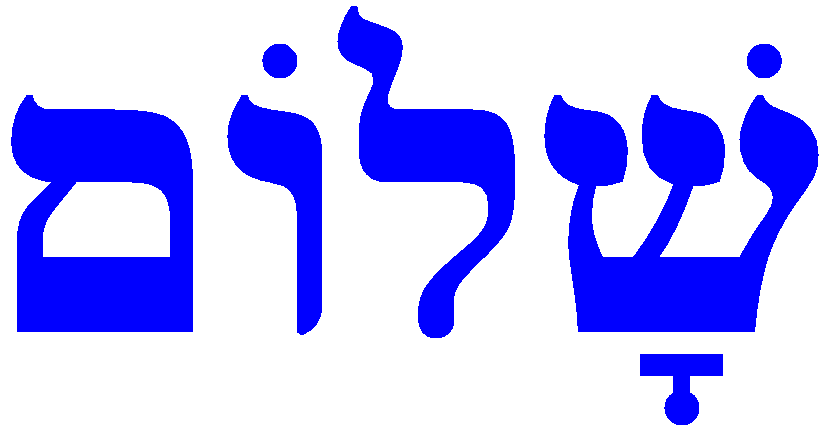|
Shalom
''Shalom'' ( ''šālōm'') is a Hebrew word meaning ''peace'' and can be used idiomatically to mean ''hello'' and ''goodbye''. As it does in English, it can refer to either peace between two entities (especially between a person and God or between two countries), or to the well-being, welfare or safety of an individual or a group of individuals. The word shalom is also found in many other expressions and names. Its equivalent cognate in Arabic is '' salaam'', '' sliem'' in Maltese, Shlama in Neo-Aramaic dialects, and ''sälam'' in Ethiopian Semitic languages from the Proto-Semitic root Š-L-M. Etymology In Hebrew, words are built on "roots", generally of three consonants. When the root consonants appear with various vowels and additional letters, a variety of words, often with some relation in meaning, can be formed from a single root. Thus from the root ''sh-l-m'' come the words ''shalom'' ("peace, well-being"), ''hishtalem'' ("it was worth it"), ''shulam'' ("was paid ... [...More Info...] [...Related Items...] OR: [Wikipedia] [Google] [Baidu] |
Š-L-M
Shin-Lamedh- Mem is a triconsonantal root of many Semitic words (many of which are used as names). The root meaning translates to "whole, safe, intact, unharmed, to go free, without blemish". Its earliest known form is in the name of Shalim, the ancient god of dusk of Ugarit. Derived from this are meanings of "to be safe, secure, at peace", hence "well-being, health" and passively "to be secured, pacified, submitted". * Central Semitic ''Š-L-M'' **, ''S-L-M'' *** **, ''Š-L-M'' **Canaanite: ''Š-L-M'' (cf. Shalem) **Hebrew: , ''Š-L-M'' (Paleo-Hebrew 𐤔-𐤋-𐤌; Samaritan Hebrew ࠔ-ࠋ-ࠌ) *East Semitic ''S-L-M'' * South Semitic "S-L-M" **, ''S-L-M'' Arabic (), Maltese ''sliem'', Hebrew (), Ge'ez (), Syriac ''šlama'' (pronounced Shlama, or Shlomo in the Western Syriac dialect) (), Mandaic ''šlama'' () are cognate Semitic terms for 'peace', deriving from a Proto-Semitic ''*šalām-''. Given names related to the same root include Solomon ( Süleyman), Absa ... [...More Info...] [...Related Items...] OR: [Wikipedia] [Google] [Baidu] |
Jewish Greetings
There are several Jewish and Hebrew greetings, farewells, and phrases that are used in Judaism, and in Jewish and Hebrew-speaking communities around the world. Even outside Israel, Hebrew is an important part of Jewish life. Many Jews, even if they do not speak Hebrew fluently, will know several of these greetings—most are Hebrew, and among Ashkenazim, some are Yiddish. Shabbat For Shabbat, there are several ways to greet people in a variety of languages, including Hebrew, Yiddish, and Judeo-Spanish. Holidays Different expressions are used for the Three Pilgrimage Festivals (Passover, Shavuot, and Sukkot) and the other Jewish holidays. Greetings and farewells There are several greetings and good-byes used in Hebrew to say hello and farewell to someone. Phrases These are Hebrew phrases used in Jewish communities both inside and outside of Israel. See also *Honorifics in Judaism *Honorifics for the dead in Judaism Among the honorifics in Judaism, there are seve ... [...More Info...] [...Related Items...] OR: [Wikipedia] [Google] [Baidu] |
As-salamu Alaykum
''As-salamu alaykum'' (, ), also written ''salamun alaykum'' and typically rendered in English as ''salam alaykum'', is a greeting in Arabic that means 'Peace be upon you'. The (, meaning 'peace') has become a religious salutation for Muslims worldwide when greeting each other, though its use as a greeting predates Islam, and is also common among Arabic speakers of other religions (such as Arab Christians and Mizrahi Jews). In colloquial speech, often only , 'peace', is used to greet a person. This shorter greeting, (), has come to be used as the general salutation in other languages as well. The typical response to the greeting is ( , 'and peace be upon you'). In the Quranic period one repeated ''as-salamu alaykum'', but the inverted response is attested in Arabic not long after its appearance in Hebrew. The phrase may also be expanded to ( , 'Peace be upon you, as well as the mercy of God and His blessings'). The use of ''salām'' as an Arabic greeting dates at least ... [...More Info...] [...Related Items...] OR: [Wikipedia] [Google] [Baidu] |
Peace
Peace is a state of harmony in the absence of hostility and violence, and everything that discusses achieving human welfare through justice and peaceful conditions. In a societal sense, peace is commonly used to mean a lack of conflict (such as war) and freedom from fear of violence between individuals or groups. Promotion of peace is a core tenet of many philosophies, religions, and ideologies, many of which consider it a core tenet of their philosophy. Some examples are: religions such as Buddhism and Christianity, important figures like Gandhi, and throughout literature like " Perpetual Peace: A Philosophical Sketch" by Immanuel Kant, " The Art of Peace" by Morihei Ueshiba, or ideologies that strictly adhere to it such as Pacifism within a sociopolitical scope. It is a frequent subject of symbolism and features prominently in art and other cultural traditions. The representation of peace has taken many shapes, with a variety of symbols pertaining to it based on ... [...More Info...] [...Related Items...] OR: [Wikipedia] [Google] [Baidu] |
Hebrew Language
Hebrew (; ''ʿÎbrit'') is a Northwest Semitic language within the Afroasiatic language family. A regional dialect of the Canaanite languages, it was natively spoken by the Israelites and remained in regular use as a first language until after 200 CE and as the liturgical language of Judaism (since the Second Temple period) and Samaritanism. The language was revived as a spoken language in the 19th century, and is the only successful large-scale example of linguistic revival. It is the only Canaanite language, as well as one of only two Northwest Semitic languages, with the other being Aramaic, still spoken today. The earliest examples of written Paleo-Hebrew date back to the 10th century BCE. Nearly all of the Hebrew Bible is written in Biblical Hebrew, with much of its present form in the dialect that scholars believe flourished around the 6th century BCE, during the time of the Babylonian captivity. For this reason, Hebrew has been referred to by Jews as '' ... [...More Info...] [...Related Items...] OR: [Wikipedia] [Google] [Baidu] |
Aloha
''Aloha'' ( , Hawaiian: �ˈlohə is the Hawaiian word for love, affection, peace, compassion and mercy, that is commonly used as a greeting. It has a deeper cultural and spiritual significance to native Hawaiians, for whom the term is used to define a force that holds together existence. The word is found in all Polynesian languages and always with the same basic meaning of "love, compassion, sympathy, kindness." Its use in Hawaii has a seriousness lacking in the Tahitian and Samoan meanings. Mary Kawena Pukui wrote that the "first expression" of ''aloha'' was between a parent and child. Lorrin Andrews wrote the first Hawaiian dictionary, called ''A Dictionary of the Hawaiian Language''. In it, he describes ''aloha'' as "A word expressing different feelings: love, affection, gratitude, kindness, pity, compassion, grief, the modern common salutation at meeting; parting". Mary Kawena Pukui and Samuel Hoyt Elbert's ''Hawaiian Dictionary: Hawaiian-English, English-Haw ... [...More Info...] [...Related Items...] OR: [Wikipedia] [Google] [Baidu] |
Arabic Language
Arabic (, , or , ) is a Central Semitic languages, Central Semitic language of the Afroasiatic languages, Afroasiatic language family spoken primarily in the Arab world. The International Organization for Standardization (ISO) assigns language codes to 32 varieties of Arabic, including its standard form of Literary Arabic, known as Modern Standard Arabic, which is derived from Classical Arabic. This distinction exists primarily among Western linguists; Arabic speakers themselves generally do not distinguish between Modern Standard Arabic and Classical Arabic, but rather refer to both as ( "the eloquent Arabic") or simply ' (). Arabic is the List of languages by the number of countries in which they are recognized as an official language, third most widespread official language after English and French, one of six official languages of the United Nations, and the Sacred language, liturgical language of Islam. Arabic is widely taught in schools and universities around the wo ... [...More Info...] [...Related Items...] OR: [Wikipedia] [Google] [Baidu] |
Namaste
''Namaste'' (, Devanagari: नमस्ते), sometimes called ''namaskār'' and ''namaskāram'', is a customary Hindu manner of respectfully greeting and honouring a person or group, used at any time of day. It is used worldwide among the Hindu, Buddhist and Jain traditions. ''Namaste'' is usually spoken with a slight bow and hands pressed together, palms touching and fingers pointing upwards, thumbs close to the chest. This gesture is called ''añjali mudrā''; the standing posture incorporating it is ''pranāmāsana''. Etymology, meaning and origins ''Namaste'' (''Namas'' + ''te'') is derived from Sanskrit and is a combination of the word ''namas'' and the second person dative pronoun in its enclitic form, '' te''.Thomas Burrow, ''The Sanskrit Language'', pp. 263–268 The word ''namaḥ'' takes the sandhi form ''namas'' before the sound ''te''.Thomas Burrow, ''The Sanskrit Language'', pp. 100–102 It is found in the Vedic literature. ''Namas-krita'' and related ... [...More Info...] [...Related Items...] OR: [Wikipedia] [Google] [Baidu] |
Italian Language
Italian (, , or , ) is a Romance language of the Indo-European language family. It evolved from the colloquial Latin of the Roman Empire. Italian is the least divergent language from Latin, together with Sardinian language, Sardinian. It is spoken by about 68 million people, including 64 million native speakers as of 2024. Italian is an official language in Languages of Italy, Italy, Languages of San Marino, San Marino, Languages of Switzerland, Switzerland (Ticino and the Grisons), and Languages of Vatican City, Vatican City; it has official Minority language, minority status in Minority languages of Croatia, Croatia, Slovene Istria, Romania, Bosnia and Herzegovina, and the municipalities of Santa Teresa, Espírito Santo, Santa Tereza, Encantado, Rio Grande do Sul, Encantado, and Venda Nova do Imigrante in Languages of Brazil#Language co-officialization, Brazil. Italian is also spoken by large Italian diaspora, immigrant and expatriate communities in the Americas and Austral ... [...More Info...] [...Related Items...] OR: [Wikipedia] [Google] [Baidu] |





